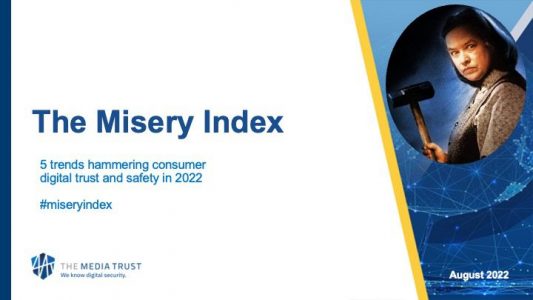Learn the top 5 things spreading misery throughout digital media—and how to shut them down
The NYC subway during a scorching August. TSA wait lines. Spotty cell network service. Out-of-stock Sony Playstation 5s. Lame hiphop collaborations. Stale potato chips.
These are all huge sources of consumer misery. Another major source of consumer misery? The digital media ecosystem.
Yes, while the Internet brings information and joy (mainly kitty pics) to the masses, it also spreads misery, often in the form of bad ad experiences—ranging from the greatly annoying to the outright malicious. Heavy ads slowing down sites, inappropriate or inflammatory creatives, and the ever-present malware menace—what makes consumers miserable, makes your job in digital advertising miserable.
The Media Trust is keeping tabs and shutting down the misery makers, but we’re also here to spread awareness of the top forms of digital consumer distress. Below we dive into the top 5 miscreants on the #miseryindex.
1. Mobile Phishing

Phishing schemes targeted to mobile devices and often executed via redirects have been ramping up with the summer heat. June saw a massive assault by this repulsive malware form, with the ever-malignant GhostCat leading the charge.
Mobile phishing is adding insult to injury—or kind of injury after insult. Digital publishers are struggling to monetize mobile web and app inventory, and bad actors take advantage of low CPMs to phish consumers. That’s like double misery.
Digital publishers have to keep vigilant—especially on the weekends, when malvertisers think no one’s watching the shop. Key to this is having a creative blocker with blocklists constantly updated by a highly experienced malware team that’s on the hunt for bad ads 24-7.
2. Fake Virus Popups

What’s old is new again—premium publishers have seen a resurgence of fake virus popups that command consumers to call “Technical Support.” You’ll be shocked (shocked!) to learn that “Technical Support” is not really there to help, but gain remote access to a device, drain a consumer’s finances, and cause whatever other misery they can.
Less tech-savvy people are particularly vulnerable to these schemes—think about your aging parents. And “Technical Support” attacks often set up backdoors or remote access for far more vicious schemes—like ransomware. An up-to-date blocklist is essential for protecting your most vulnerable audiences.
3. Scams on the Rise

Since the beginning of the pandemic, The Media Trust has seen an explosion in straightforward scams—no funny business in the code, just misleading creative and other deceptions designed to maximize consumer misery.
There’s a wide variety of scams out there:
- Bogus retailers
- Fake cures for serious medical issues like diabetes
- Shady lead-gen schemes that sell your data to other scammers
At the very least, these low-quality ads make your sites and apps look like MySpace 2010—they’re downright bad for user experience and not really worth the pittance of CPM they bring in. Scams are also tougher to identify than malware, where the maliciousness is in the code. Flagging scams requires a security team to research and verify—make sure your real-time ad quality solution is backed up by a team doing the diligence so you can block the deluge of scams before the UK Online Safety bill regulates it for you.
4. Heavy Ads

The industry has an ad obesity problem—creative needs to go on a diet.
This is not just a problem of low-quality advertisers with bad designers. Premium advertisers also have challenges putting out reasonably-sized creative as denoted by the variety of ads above.
Publishers have to shut heavy ads down before Google Chrome starts intervening—and costs you revenue. The key is to identify and halt heavy ads—and then call your demand source to replace them with slimmer creative.
5. Political Ads

We know you’re not supposed to mix politics and work, but… well, politics happens to be invading your work.
The Media Trust’s major DSP and SSP partners are already seeing an influx of political creatives featuring weapons and inflammatory rhetoric. It’s clear the US is in for another painful election season, but it’s hard for a premium publisher to turn down that fruitful revenue stream.
Do you want to make the drastic—though increasingly common—decision to ban all political ads? Or do you want to develop specific policies around what is and what is not allowed in political advertising (e.g., commentary on immigration, weapons), and then use tools to block individual creatives that don’t meet your standards?
Your policies around political ads must be rock solid, or quickly enough readers, editorial, and executives will be screaming about offensive political content.
Relieve the Misery
While the factors causing consumers misery in digital media are many, none of them are insurmountable. Relieving consumer’s digital media misery is all about strategizing and developing —as well as employing advanced tools that can execute on those nuanced policies. The Media Trust is here to help on all fronts—why not reach out and tell us what ails your consumers?

